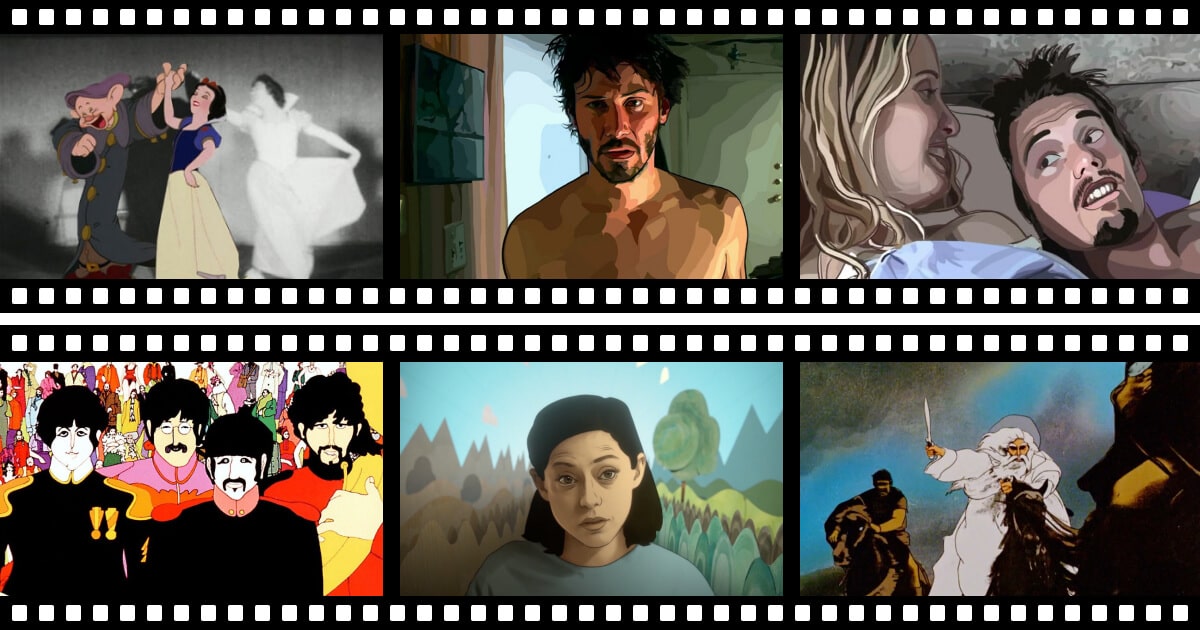- What Is Rotoscope Animation?
- Rotoscoping Animation Examples & Applications
- The Impact of Data Annotation on the Process of Rotoscoping: A Closer Look
In the movie “Waking Life” (2001), director Richard Linklater used rotoscoping animation to create a dream-like style. What’s interesting is that some actors were recorded without knowing they were being filmed, and their conversations were used as the basis for the film’s dialogue, blurring the line between reality and fiction.
Rotoscoping can be a powerful tool for experimentation and creating innovative, boundary-pushing films. But what is rotoscope animation, and how does it relate to the process of data annotation? Have you ever heard of or maybe seen a rotoscoped animation movie?
In the dynamic world of animation, rotoscoping remains a core technology to achieve the realistic and fluid motion of animated sequences. With the introduction of machine learning, this process has been redefined to deliver improved efficiency and accuracy, like never before.
In this article, we’ll explain the process of rotoscoping animation and the significance of data annotation in enhancing the quality and speed of the entire animation production process.
With that said, let’s dive right in!
What Is Rotoscope Animation?
If you’re wondering what is rotoscope animation, it is a remarkable technique that has played a crucial role in producing iconic films and television shows, such as Star Wars and Game of Thrones. The technique entails the process of tracing over each frame of live-action footage to produce natural and lifelike movements in the animated characters.
Using this method, animators transform a live-action video into an animation to create visually stunning animated sequences that are faithful to the original scenes while still allowing for some artistic freedom. Although rotoscoping can be laborious and time-consuming, automated solutions have revolutionized the technique by combining it with smart tech solutions, resulting in more engaging and dynamic visual media.
AI can enhance rotoscope animation by automating the tracing and reducing the time and effort required to produce accurate and high-quality animation. For example, AI video recognition can provide a more automated and efficient way to annotate frames, which can then be used to create highly accurate and detailed rotoscoped images. Whether it is accomplished manually or through the use of software, the result is nothing short of breathtaking.
Rotoscoping Animation Examples & Applications

Rotoscoping animation has the power to bring to life an entirely new world of animation, one that captures the imagination and transports us to new and exciting realms. Therefore, the technique has been used in various popular film and animation projects.
Here are some of the most well-known rotoscoping animation examples:
- Snow White and the Seven Dwarfs: This 1937 Disney classic was one of the first films to use rotoscoping to create lifelike movement in the characters in the dance scenes with Snow White and the Prince.
- A Scanner Darkly: Directed by Richard Linklater in 2006, this cult classic used rotoscoping to create a dystopian world with realistic-looking characters.
- Waking Life: Also directed by Linklater, this 2001 film used rotoscoping to create a dreamlike atmosphere with animated characters involved in a series of philosophical discussions.
- The Beatles’ Yellow Submarine: Released in 1968, this animated film used rotoscoping to create the psychedelic landscapes and characters featured in the movie.
- Undone: This 2019 Amazon Prime original series used rotoscoping to blend live-action footage with animation to create a visual style that enhances the surreal and introspective tone of the story.
- The Lord of the Rings: The Lord of the Rings (1978) was animated using rotoscoping to make battle scenes more dynamic. Meanwhile, Peter Jackson’s live-action adaptation (2001) used motion capture to create Gollum using CGI (computer-generated imagery).
- Guardians of the Galaxy: In this piece, rotoscoping was used to create Rocket Raccoon, where the character was traced onto live-action footage of a real raccoon.
These rotoscoping films have achieved critical and commercial success, contributing to the popularity of rotoscoping as an animation technique. For this reason, filmmakers actively use this method to create masks or mattes for specific elements (e.g., characters or objects) to extract them from a scene or re-color them. This helps them create scenes that are difficult or impossible to achieve otherwise.
Apart from animated movies, rotoscoping is now used in the gaming industry to develop realistic and immersive gaming experiences. Game developers use rotoscoping to create authentic character animations that respond to in-game situations, thus improving the overall gaming experience. Additionally, rotoscoping has been employed in restoring classic films, enhancing the quality of the footage, and making it more visually appealing.
The Impact of Data Annotation on the Process of Rotoscoping: A Closer Look
The integration of AI in media has revolutionized rotoscoping animation, enabling precise results and new creative possibilities. More specifically, the incorporation of machine learning and data annotation has significantly improved the rotoscoping process, enabling more precise and efficient frame-by-frame animation for stunning visual effects in films and video productions. This also resulted in the development of new software and tools designed to streamline the process.
Machine learning algorithms, for instance, can automate certain aspects of rotoscoping by identifying and tracing the outlines of people and objects in each frame of the original footage. This technique can be particularly beneficial when dealing with complex footage or when many animation frames need to be traced. Yet, as the saying goes, “garbage in, garbage out,” and this rings true in the world of machine learning, where accurate data annotation is crucial for achieving high precision.
Before, animators traced over live-action footage by projecting it onto a glass panel. Nowadays, rotoscoping is mostly done using rotoscope animation software. The challenge here is that automated rotoscoping might not always be consistent and precise, particularly when attempting to trace every frame of the original footage. This is when data annotation kicks in.
Data annotation in AI helps machines recognize object boundaries in video frames. It aids in the creation of accurate rotoscoping output, a manual process of extracting and isolating objects in the video for editing or compositing purposes. Also, data annotation can be employed to recognize and label key features, such as the contours of individuals and objects, in every frame of the source footage. With this, the process of rotoscoping can be faster, and the resulting animated sequence can be more precise and true to the original footage.
We can also compare the tools and workflow used in rotoscoping and data annotation, as they share many similarities. Rotoscoping and professional annotation tools both support object tracking, polygon and spline editing, and adjustment of brightness and contrast to enhance edge detection. However, a crucial distinction is that in rotoscoping, transparency helps capture motion blur and hair details. In contrast, in segmentation, there are typically predefined classes with no interpolation between them.
How It Works: Step-by-Step Guide to Explain the Process of Rotoscoping
Learn how to rotoscope with these basic steps if you’re interested in trying this animation technique:
- Select the footage you want to rotoscope: it can be your own live-action footage or acquired from another source.
- Import the footage into rotoscoping software like Nuke, Silhouette, or Adobe After Effects.
- Begin tracing each frame manually using a stylus or mouse, or use the software’s automated tracing features.
- Use data annotation to identify crucial elements in each frame, like people and objects’ outlines.
- Use ML algorithms to speed up the tracing process, if preferred.
- Adjust the final animated sequence for the desired artistic effect.
Overall, rotoscoping animation is a potent technique used in numerous popular movies and TV shows. We hope that by following these simple steps, you can better understand how to rotoscope animation and take your content to the next level.
Final Words
Over the years, the technique of rotoscoping in animation has been gaining momentum, all thanks to the possibilities offered by AI. By leveraging the potential of machine learning and data annotation, animators can now create high-quality animations with greater ease and precision, leaving a lasting impression on their viewers.
In this piece, we’ve explored the fascinating process of creating a rotoscoped image and how it can bring a new level of depth and realism to animated films or music videos. But as technology continues to advance, we can expect even more exciting developments in the future of rotoscoping animation, ensuring that it remains a vital technique for producing spectacular animated sequences.
Don’t let the daunting task of rotoscoping hold you back from creating amazing content. Get started today and bring your vision to life with expert data annotation for your rotoscope animations!
*Please note that all videos included in this article are for educational purposes only and have been obtained from various reliable resources.
FAQ
-
Is rotoscoping still used today?
Yes, rotoscoping is still a common type of animation used in the visual effects industry today. Despite the process being turned digital, the term “rotoscoping” has remained in use.
-
What are the purposes of rotoscoping?
Rotoscoping is used to create a mask for an element, extract it for use on a different background, and produce rotoscope animation by tracing over live-action footage for realistic animation effects.
Table of Contents
Get Notified ⤵
Receive weekly email each time we publish something new:

